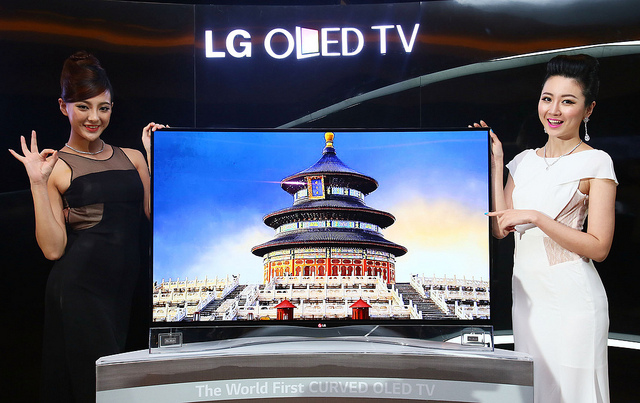Lately, several prominent Japanese and Korean manufacturers have dropped OLED TV projects. Japanese manufacturers Panasonic delayed OLED display mass production plans, Sony halted OLED TV R&D, while Korean manufacturer Samsung decided to stop investing in OLED displays in 2014. LG Electronics is the only North Asian manufacturer still active in OLED R&D, according to a recent report by Chinese-language ENorth Netnews.
The TV industry once had high hopes for OLED TV, which was believed to become the next generation TV after LCD. Yet, high costs continued to be OLED TV’s “Achilles heel,” which caused TV manufacturers to collectively abandon OLED. Another trend contributing to the loss of interest in OLED has been LCD’s continual price drops, improved quality, which has revived TV manufacturers preference for LCD TV.
 |
|
LG's curved OLED TV. (Photo Source: LGEPR via photopin cc) |
Panasonic began applying OLED printing technology developed with Sony in 2012, but announced the termination of the R&D partnership in late 2013. The company also announced OLED facilities will be shifted to medicine and other application fields. According to the original plan, Panasonic OLED panels were going to be mass produced during fiscal year 2015, yet it will be delayed to 2016 or later.
Lowering costs has been the major obstacle for Panasonic’s OLED development. Estimations by industry experts noted, Panasonic’s 55-inch OLED TV costs about JYP 1 million (US$ 9,689), but a same sized Ultra Hard Definition (UHD) LCD TV is sold at less than half that price of about JYP 300,000 to JYP 400,000 in large consumer electronic retail stores.
Recently, Sony also announced freezing OLED TV R&D, while turning its focus to medical and broadcasting applications. The company, which has a 20 percent share in the global UHD TV market, plans to expand its UHD TV production line to further lower manufacturing costs.
Korean manufacturer Samsung has cancelled its OLED production capacity expansion plan in 2014, and currently has no plans of launching new OLED TV models.
Related data showed the OLED TV shipment market only reached 4,000 units in 2013, only 1.6 percent of the market’s estimation in Spring 2012.
“OLED TV has lost its advantages as LCD TV definition improves, and prices are lowered,” said Hisakazu Torii, Vice President, Japanese TV Market Research, Display Search.












